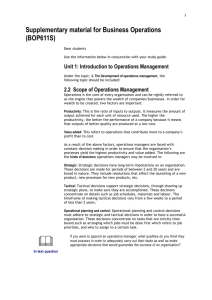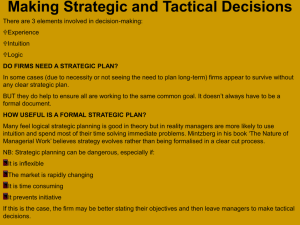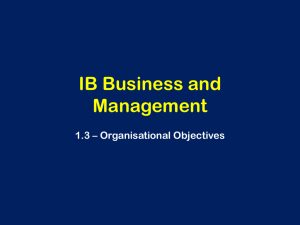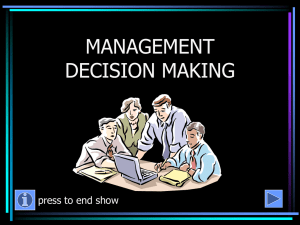IT Applications Theory Slideshows - VCE IT Lecture Notes by Mark
advertisement
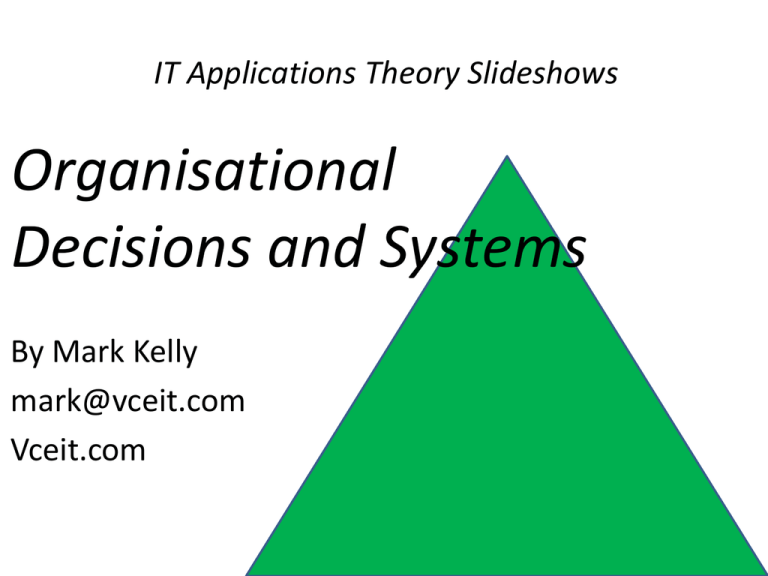
IT Applications Theory Slideshows Organisational Decisions and Systems By Mark Kelly mark@vceit.com Vceit.com Organisation Hierarchy • A hierarchy (say “higher arky”) is an arrangement where there are different levels of authority or power. • Organisations usually have a hierarchical structure, where some people are more powerful or important than others. Typical hierarchy in organisations Typical hierarchy in organisations STRATEGIC Typical management hierarchy in organisations STRATEGIC TACTICAL Typical management hierarchy in organisations STRATEGIC TACTICAL OPERATIONAL STRATEGIC DECISION MAKERS • The very highest level of the hierarchy • Make very big decisions that: – Must consider the whole organisation, not just part of it – Are expensive – Are long-term (e.g. years) – Could be disastrous if wrong – Define the nature of the organisation – Changes the organisation’s future STRATEGIC DECISION MAKERS Typical Strategic level job titles: - Chairman - President - CEO (Chief Executive Office) - Board of Directors - General Manager Tactical Management • These people are still high-level, and make important decisions in their own areas • But they follow instructions from above: from the strategic management. • Tactical managers implement the decisions made at the strategic level. • They take a big idea and work out how to make it happen • Their decisions are usually limited to a sector of the org (e.g. advertising, transport) rather than the whole org. Typical Tactical-Level Job Titles • • • • • • Advertising manager Personnel manager Creative director Manager of information systems Communications director Chief Financial Officer Tactical decisions • Implement strategic decisions • Are medium-term (e.g. months, weeks) • Are passed down to the next level of management… Operational Management • Operational managers directly manage nonmanagement staff and the public. • They make day-to-day decisions that are vital to actually make things, sell things, provide services. • They are at the ‘coal face’ doing business and making money. Typical operational job titles • Store manager • Foreman • Army Sergeant Strategic Example • The prime minister and parliament decide to invade New Zealand. • They are top-level STRATEGIC decisionmakers. They decide on a big, important, risky moves. Let’s invade New Zealand Strategic • They do not carry out the invasion themselves, but they take the big decision and issue the order to the tactical managers. Start the invasion, General I’ll get right on it, Sir …then attack the sheep here and here Tactical (continued) • They muster troops • They order the purchase of anti-sheep weapons, ammunition, food, medical supplies etc • Each tactical manager has a specific area of responsibility to focus on Operational management • But not even the general and colonels will be wrestling sheep to the ground. • They pass their orders to the operational managers: the lieutenants and sergeants. • These operational managers are command the non-management personnel who actually get the job done… the troops. Operational management • The captains tell the lieutenants which way to lead their troops into the town. • The lieutenants tell the sergeants which buildings to take out. • The sergeants choose which men will lead the attack. • The troops (non-management) actually do the shooting. Operational management • Operational managers deal directly with nonmanagement personnel. • They are the final and vital link in the chain of command that leads to action. • Their decisions are immediate and have a lead time of mere days or hours. Example 2 • Supershop, a statewide chain of grocery stores wants to increase its profit. • The board of directors discusses how to best achieve this. • They decide they will move into the pharmacy sector and include chemist shops in their stores. • This is a big departure from their usual business. It’s a strategic decision. Tactical • The directors instruct the tactical managers to implement the decision. • The personnel manager advertises for pharmacists to be employed. • The publicity manager plans a TV & newspaper campaign to advertise the change. • The facilities manager puts out tenders for the construction work needed. Operational • The builders arrive at a local supermarket. • The supermarket manager instructs staff to reorganise shelving to allow the construction of the pharmacy. • The manager chooses and arranges training for staff who will be working in the pharmacy. Non-management • Cheryl, the checkout chick, empties out the shelves where the pharmacy will be built. • Her decision-making is limited to “I’ll need to get a trolley to take these cans to the other shelves.” Drawing the line • Sometimes it’s hard to decide whether a decision is strategic, tactical or operational. • It can depend on the size of the organisation. Drawing the line • E.g. for Safeway, building a new million-dollar store is a relatively minor tactical decision, but for the manager of a single gift shop, building a second store is a massive, strategic decision. Drawing the line • Judge whether the decision will have a significant impact on the organisation over quite some time. That would be strategic. Drawing the line • If the decision is made to implement a decision made by a higher-ranking person (but it doesn’t actually achieve the end by itelf), it’s tactical. Drawing the line • If a decision actually leads workers to doing something that makes the plan work, it’s operational. IT APPLICATIONS SLIDESHOWS By Mark Kelly mark@vceit.com vceit.com These slideshows may be freely used, modified or distributed by teachers and students anywhere on the planet (but not elsewhere). They may NOT be sold. They must NOT be redistributed if you modify them.



